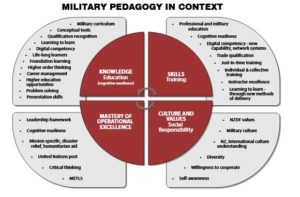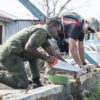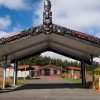By Miss D. Shirley
Why should we entertain the thought of having a military education system that simultaneously values higher education and development of life-long learners; while delivering educational programs that are focused on enabling the New Zealand Defence Force to better adapt to strategic, operational and tactical challenges? How do educational programmes that aim to develop excellent war f ighters f it into an education pedagogical philosophy, if at all?
Pedagogy is the art of teaching and learning. Military pedagogy reflects the complexity of modern adaptive military tasks, ethics, morale, military education and engagement. Royl (2002) describes military pedagogy as “the demand to both locate and define the present state of the art of war and the lines of natural expectation; and to be able to change or transform war fighting methods in order to make progress instead of repeating the habits of the past” (as cited in Annen, 2002, p. 28). In other words, our educational landscape within the New Zealand Defence Force (NZDF) should continuously adapt to the needs of the NZDF and its personnel, and not the other way around.
There are two distinct contexts in which military pedagogy is different from other education pedagogies. Firstly, military pedagogy requires that the teaching and learning take place in a military setting. Secondly, military pedagogy applies to situations in which the teaching and learning is for military purposes.
According to Schunk & Nielsson (2007), military pedagogy is applied in the following context:
- Military personnel are willing to cooperate during military education and training, which means that during the process of knowledge acquisition they are more likely to adapt in order to gain proficiency.
- Personnel are trained to survive and work under extreme conditions.
- Personnel must be able to carry out their duties effectively and efficiently.
- Personnel are considered adults undertaking military tasks as an armed force.
- Instructors are not always trained to instruct; they are subject matter experts, administrators and tactical commanders (they are generally uniformed military personnel), but may not necessarily be full-time instructors.
What is Military Pedagogy?
Juhary (2014) states that military pedagogy is one of the “military sciences that looks into the philosophies, conceptions, visions, doctrines, aims, approaches, and technologies of military education and training” (p. 1256). Juhary (2014) explains that the role of military pedagogy will increase due to the demands of higher education opportunities for military personnel. The Danish military defines military pedagogy as a tool to solve problems related to learning for military education and training (Schunk & Nielsson, 2007). According to Schunk and Nielsson (2007), the term military pedagogy is in principle no different from normal pedagogy. However, there are unique characteristics that differentiate military pedagogy from other pedagogy.
Characteristics of Military Pedagogy
- Besides proficiency and knowledge, military training aims to ensure the acquisition of certain qualities including morale in combat, motivation and loyalty. These characteristic are linked to the the willingness and ability of individuals to cooperate.
- Military units must be fit to undertake and carry out tasks under conditions of extreme strain. Military forces operate on battlefields, in high-pressure international training environments and in extreme climates and terrains.
- It is the military unit that must be made fit to carry out tasks through education and training. The unit’s function is the primary driver of training, whereas the objectives for the training of the individual military personnel are determined by his or her function within the unit.
- Military personnel under training are adults. This feature is tied to the departure point, and represents an advantage for military pedagogy in that maturity can be assumed, which is a condition for learning to a higher degree.
- Instructors normally have other functions besides their pedagogic tasks. They can also be tactical commanders and administrators.
- Military training is conducted in a diverse environment, with varying levels of cognitive ability, learning skills, prior knowledge, learning preferences or methods. The context, method of delivery, structure of the training, relevance and just-in-time nature will vary according to the operational task or instruction taking place (Schunk & Nielsson, 2007).

Figure 1: Example of Contextualising an NZDF Military Pedagogy
What does Military Pedagogy Achieve?
International threats to security have become more agile and unpredictable, so our military is required to be adaptable, prepared for the unexpected, and in possession of higher order thinking, cognitive and operational readiness. “The only thing certain about the future is that it is impossible to predict. The only logical strategy is to be ready for anything” (Future 20/20).
NZDF military training and education is effective, but is also moving away from its current industrial model of training and education in response to the changing environment and to the speed and complexity that our personnel are faced with on a daily bases. However, the risk is that ongoing adaption and training for the sake of training will exhaust resources and minimise the effectiveness of learning. The risk of not adopting a New Zealand military pedagogical approach (where all training and education is mapped and where, for example, leadership culture, sustainability, ethos and values, are embedded under one educational umbrella) is that NZDF personnel will continue to be considered as nothing more than a ‘car being manufactured on a processing line’.
Secondly, by not adopting a military pedagogy approach the NZDF will continue to have projects working in silos and not coordinated under the one framework for the one purpose – military excellence. If we continue to do the same thing, we will get the same results. Early results from various projects (including analysis on who are our learners e.g. foundation learning, Joint Instructor Excellence; adult learning programs e.g. literacy and numeracy), Joint Professional Military Education ( JPME) and network support systems have identified that there is a gap in learning programs. If the gap continues to be ignored, instructors and NZDF schools will continue to carry the risk.
Military education and training is the prime focus of military pedagogical theory. Adopting a military pedagogy philosophy aligns NZDF with Future 20/20: better tools, better support, better information and better strategies towards military excellence. Dedication to military excellence will involve aligning projects, including foundation learning, instructor excellence and the provision of qualifications (whether aligned under Defence Proficiency Military Excellence or external qualifications), under one framework. It will also require commitment to reaffirming the value of education and training in a military context.
By adopting a military pedagogy approach within the NZDF, there is greater need to adopt a curriculum framework that includes professional education specialists. These specialists will continue to support and develop instructor competencies, foundation learning opportunities and higher order thinking skills embedded into all areas of training, in order to support operational and cognitive readiness and to produce adaptable war fighters.
Military Pedagogy as a Determinant of Professional Mastery
Military pedagogy is a determinant for embedding professional mastery into training that includes the cultivation of skills and knowledge needed to take effective action in response to changing circumstances. The concept also includes developing judgment that is based on appropriate individual and organisational experience and values. An individual who is said to possess professional mastery:
- understands and acquires the necessary knowledge as the basis for sensible action;
- has a set of professional values against which to determine right and wrong;
- understands the practice of their profession in a wide range of difficult circumstances;
- is able to employ skills and knowledge for creativity;
- understands the importance and value of working with others; and
- has the ability to manage their own life, to cope with the prevailing environment, to profit from experience, to reach sensible decisions and to act on them.
Professional mastery is defined as integrating all the components of being a war fighter. It is an expression of personal competence displayed by an individual’s ability to combine character, self-confidence, effective leadership, professional knowledge, professional military judgement and experience. It is measured by performance in battle and is a process of continual learning developed through education, training and experience. The most critical ingredient for success is the human element: how well personnel adapt to challenges and their environment.
Training and education is a foundational aspect to the intellectual component of warrior culture. Implicit in this description is the idea that professional mastery is a state that changes as individuals continually learn and interact with their environment. It presupposes that individuals not only have the ability to perform their functions competently, but also that they have an awareness of why their functions are necessary, along with the flexibility and confidence to perform them in a range of circumstances.
Individual Contribution to Professional Mastery
At its most abstract, professional mastery is the demonstrated level of skill applied to the art and science of war. People are the intellectual component of warfighting capability within the NZDF. They generate the innovative concepts and solutions to challenges. When the organisation provides opportunity through leadership, its people provide the potential and drive to take advantage of those opportunities.
On a more practical level, professional mastery is an expression of how an individual applies the skills, knowledge and attitudes developed through education, training and experience to meet the requirements of the task at hand. Individual professional mastery forms the basis of NZDF’s collective professional mastery, in which excellence in all aspects of the profession of arms creates a unified field of applied knowledge. Each learner’s progression is tracked electronically over their career. Managers and individuals identify gaps and align educational opportunities against the framework.
A military pedagogy will shape the lineal framework for professional mastery. When an organisation and managers set expectations and have transparent frameworks in place, then individuals are more likely to take responsibility for learning and become self-directed in seeking knowledge. Even when professional progression may not be their desire, the organisation strongly advocates further education, to empower them to be lifelong learners and informed citizens.
Breaking Down Professional Mastery
At the basic level within the NZDF, professional mastery will flag key competencies that are learnt through military training and education activities. These competencies are the ability to perform activities within an occupation, function or role to the standard required. The concept of competency relates to the ability to perform a task in the workplace (the expected outcome), rather than the process of acquiring the necessary skills (the learning process). It embodies the ability to transfer and apply skills, knowledge and attributes to new situations and environments.
Through military training and education these competencies foster the skills, knowledge and attributes in individuals and teams necessary to fight and win in the modern battlespace. Train and develop for certainty, educate for uncertainty. Quality training and education ensures our personnel are able to carry out their tasks and responsibilities to the required standard of performance so the organisation can successfully fulfil its role.
Education assists personnel to shift from tactical, operational and strategic views to a holistic view. For NZDF, individual training, education and development of its personnel involves the following:
- Individual vocational education and training for induction, employment and to support the introduction of new capabilities.
- Language, literacy and numeracy, including general secondary education (Year 12 or equivalent), to meet the professional entry requirements.
- Higher education to prepare individuals for specialist and career appointments; refresher and continuation training to maintain competency.
- Cross-training and multi-skilling to improve efficiency and to provide job enrichment.
- Career transition and resettlement to prepare individuals for careers outside the NZDF.
Characteristics of Effective Training and Education
The characteristics of effective training and education are the same in any organisation. Regardless of the level at which it is developed or implemented, effective training has the following broad characteristics:
- It is based on clearly articulated and relevant training objectives.
- It progressively builds professional mastery in accordance with NZDF’s training and education continuum.
- It develops the skills, knowledge and attributes required for successful performance on operations.
- It develops the skills, knowledge and attributes required for successful performance on operations.
- It is task-oriented to the greatest extent possible.6.It simulates operational conditions wherever possible.
- It makes efficient use of available time and resources; employs a wide range of techniques to maintain interest and emphasises practical activities at an appropriate level of complexity.
Conclusion
All NZDF personnel are vital links in a larger chain. The strength of the chain is dependent on the quality of each individual in training. Training and education aims to, firstly, modify or change an individual’s or group’s level of competency for a particular task. Secondly, it seeks to continually improve the processes used to train individuals or groups to meet various military requirements. Finally, the NZDF is a unique organisation that should not be classified under ‘classical’ education categories. The NZDF should define its own pedagogy. By defining its military pedagogy, NZDF will be able to apply systematic methods and processes to develop the people who will build, maintain, enhance and apply military capability. By its very nature, military pedagogy provides training and education that is dynamic and must be fostered and encouraged to permeate all levels of the organisation. Training and education is the means by which personnel acquire the competencies and beliefs that affect their behaviour and ability to perform.
The enduring challenge confronting NZDF is to train to be successful in future operations. In other words, NZDF requires our war fighters to be agile thinkers and adaptable decision-makers. This high level of professionalism can be achieved through the maintenance of high levels of training that is attained through well-planned application of training, education and development activities to an individual in accordance with NZDF’s operational requirements, their career requirements and their own individual desires.






